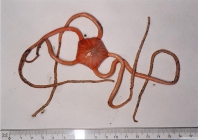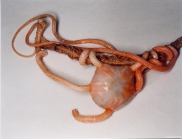Deep-Sea taxon details
Asteronyx loveni Müller & Troschel, 1842
124951 (urn:lsid:marinespecies.org:taxname:124951)
accepted
Species
Asteronyx dispar Lütken & Mortensen, 1899 · unaccepted (synonym)
marine, brackish, fresh, terrestrial
Müller, J. and Troschel, F. H. (1842). System der Asteriden.1. Asteriae. 2. Ophiuridae. <em>Vieweg: Braunschweig.</em> xxx+134 pp. 12 pls., available online at http://www.biodiversitylibrary.org/item/44159 [details] 
Distribution In more than 100 m depth, clinging to sea pens and gorgonians towards the edge of the continental shelf and in some...
Distribution General distribution: temperate, discontinuous (Pacific and Atlantic Oceans), depth range 62-2963 m. (Rowe & Gates, 1995).
Distribution In more than 100 m depth, clinging to sea pens and gorgonians towards the edge of the continental shelf and in some Scottish sea lochs.
Almost cosmopolitan in depths of 100 to 1800 m. [details]
Almost cosmopolitan in depths of 100 to 1800 m. [details]
Distribution General distribution: temperate, discontinuous (Pacific and Atlantic Oceans), depth range 62-2963 m. (Rowe & Gates, 1995).
Distribution General distribution: temperate, discontinuous (Pacific and Atlantic Oceans), depth range 62-2963 m. (Rowe & Gates, 1995).
Also recorded in Australia (Rowe & Gates, 1995). [details]
Also recorded in Australia (Rowe & Gates, 1995). [details]
Stöhr, S.; O’Hara, T.; Thuy, B. (Eds) (2024). World Ophiuroidea Database. Asteronyx loveni Müller & Troschel, 1842. Accessed through: Glover, A.G.; Higgs, N.; Horton, T. (2024) World Register of Deep-Sea species (WoRDSS) at: https://www.marinespecies.org/deepsea/aphia.php?p=taxdetails&id=124951 on 2024-04-20
Glover, A.G.; Higgs, N.; Horton, T. (2024). World Register of Deep-Sea species (WoRDSS). Asteronyx loveni Müller & Troschel, 1842. Accessed at: https://www.marinespecies.org/deepsea/aphia.php?p=taxdetails&id=124951 on 2024-04-20
Date
action
by
original description
Müller, J. and Troschel, F. H. (1842). System der Asteriden.1. Asteriae. 2. Ophiuridae. <em>Vieweg: Braunschweig.</em> xxx+134 pp. 12 pls., available online at http://www.biodiversitylibrary.org/item/44159 [details] 
original description (of Asteronyx dispar Lütken & Mortensen, 1899) Lütken, C. F.; Mortensen, T. (1899). Reports on an exploration off the west coasts of Mexico, Central and Southern America and off the Galapagos Islands. XXV. The Ophiuridae. <em>Memoirs of the Museum of Comparative Zoology.</em> 23(2): 97-208., available online at https://www.biodiversitylibrary.org/page/28891692 [details]
context source (Deepsea) Smirnov I.S., Piepenburg D., Ahearn C., Juterzenka K.V. (2014). Deep-sea fauna of European seas: An annotated species check-list of benthic invertebrates living deeper than 2000 m in the seas bordering Europe. Ophiuroidea. <i>Invertebrate Zoology</i>. Vol.11. No.1: 192–209 [in English]. [details] Available for editors
basis of record Clark, A. M.; Courtman-Stock, J. (1976). The echinoderms of southern Africa. Publ. No. 766. British Museum (Nat. Hist), London. 277 pp. [details]
additional source Southward, E.C.; Campbell, A.C. (2006). [Echinoderms: keys and notes for the identification of British species]. <i>Synopses of the British fauna (new series)</i>, 56. Field Studies Council: Shrewsbury, UK. ISBN 1-85153-269-2. 272 pp. (look up in IMIS) [details]
additional source Mah, C.L.; McKnight, D.G.; Eagle, M.K.; Pawson, D.L.; Améziane, N.; Vance, D.J.; Baker, A.N.; Clark, H.E.S.; Davey, N. (2009). Phylum Echinodermata: sea stars, brittle stars, sea urchins, sea cucumbers, sea lilies. In: Gordon, D.P. (Ed.) (2009). New Zealand inventory of biodiversity: 1. Kingdom Animalia: Radiata, Lophotrochozoa, Deuterostomia. pp. 371-400. [details]
additional source Hansson, H. (2004). North East Atlantic Taxa (NEAT): Nematoda. Internet pdf Ed. Aug 1998., available online at http://www.tmbl.gu.se/libdb/taxon/taxa.html [details] Available for editors
additional source Hansson, H.G. (2001). Echinodermata, <B><I>in</I></B>: Costello, M.J. <i>et al.</i> (Ed.) (2001). <i>European register of marine species: a check-list of the marine species in Europe and a bibliography of guides to their identification. Collection Patrimoines Naturels,</i>. 50: pp. 336-351. (look up in IMIS) [details]
additional source Liu, J.Y. [Ruiyu] (ed.). (2008). Checklist of marine biota of China seas. <em>China Science Press.</em> 1267 pp. (look up in IMIS) [details] Available for editors
original description (of Asteronyx dispar Lütken & Mortensen, 1899) Lütken, C. F.; Mortensen, T. (1899). Reports on an exploration off the west coasts of Mexico, Central and Southern America and off the Galapagos Islands. XXV. The Ophiuridae. <em>Memoirs of the Museum of Comparative Zoology.</em> 23(2): 97-208., available online at https://www.biodiversitylibrary.org/page/28891692 [details]
context source (Deepsea) Smirnov I.S., Piepenburg D., Ahearn C., Juterzenka K.V. (2014). Deep-sea fauna of European seas: An annotated species check-list of benthic invertebrates living deeper than 2000 m in the seas bordering Europe. Ophiuroidea. <i>Invertebrate Zoology</i>. Vol.11. No.1: 192–209 [in English]. [details] Available for editors
basis of record Clark, A. M.; Courtman-Stock, J. (1976). The echinoderms of southern Africa. Publ. No. 766. British Museum (Nat. Hist), London. 277 pp. [details]
additional source Southward, E.C.; Campbell, A.C. (2006). [Echinoderms: keys and notes for the identification of British species]. <i>Synopses of the British fauna (new series)</i>, 56. Field Studies Council: Shrewsbury, UK. ISBN 1-85153-269-2. 272 pp. (look up in IMIS) [details]
additional source Mah, C.L.; McKnight, D.G.; Eagle, M.K.; Pawson, D.L.; Améziane, N.; Vance, D.J.; Baker, A.N.; Clark, H.E.S.; Davey, N. (2009). Phylum Echinodermata: sea stars, brittle stars, sea urchins, sea cucumbers, sea lilies. In: Gordon, D.P. (Ed.) (2009). New Zealand inventory of biodiversity: 1. Kingdom Animalia: Radiata, Lophotrochozoa, Deuterostomia. pp. 371-400. [details]
additional source Hansson, H. (2004). North East Atlantic Taxa (NEAT): Nematoda. Internet pdf Ed. Aug 1998., available online at http://www.tmbl.gu.se/libdb/taxon/taxa.html [details] Available for editors
additional source Hansson, H.G. (2001). Echinodermata, <B><I>in</I></B>: Costello, M.J. <i>et al.</i> (Ed.) (2001). <i>European register of marine species: a check-list of the marine species in Europe and a bibliography of guides to their identification. Collection Patrimoines Naturels,</i>. 50: pp. 336-351. (look up in IMIS) [details]
additional source Liu, J.Y. [Ruiyu] (ed.). (2008). Checklist of marine biota of China seas. <em>China Science Press.</em> 1267 pp. (look up in IMIS) [details] Available for editors
 Present
Present  Inaccurate
Inaccurate  Introduced: alien
Introduced: alien  Containing type locality
Containing type locality
Syntype (of Asteronyx dispar Lütken & Mortensen, 1899) MCZ OPH-2816 [details]
Syntype (of Asteronyx dispar Lütken & Mortensen, 1899) MCZ OPH-2875 [details]
Syntype (of Asteronyx dispar Lütken & Mortensen, 1899) MCZ OPH-2876 [details]
Syntype SMNH Type-3287, geounit Kattegat [details]
Syntype SMNH Type-3288, geounit Finnmark [details]
Syntype SMNH Type-3732, geounit Kattegat [details]
From other sources
Breeding Large eggs, probably direct development [details]Distribution In more than 100 m depth, clinging to sea pens and gorgonians towards the edge of the continental shelf and in some Scottish sea lochs.
Almost cosmopolitan in depths of 100 to 1800 m. [details]
Distribution General distribution: temperate, discontinuous (Pacific and Atlantic Oceans), depth range 62-2963 m. (Rowe & Gates, 1995).
Also recorded in Australia (Rowe & Gates, 1995). [details]
Habitat Known from seamounts and knolls [details]
| Language | Name | |
|---|---|---|
| English | Pipe-cleaner brittlestar | [details] |
| Japanese | キヌガサモヅル | [details] |
| Russian | Астероникс Ловена | [details] |
| Swedish | piprensarormstjärna | [details] |
Marine Life Information Network - UK
To Barcode of Life (22 barcodes)
To Biodiversity Heritage Library (11 publications) (from synonym Asteronyx dispar Lütken & Mortensen, 1899)
To Biodiversity Heritage Library (76 publications)
To Biological Information System for Marine Life (BISMaL)
To Dyntaxa
To European Nucleotide Archive (ENA)
To GenBank (84 nucleotides; 35 proteins)
To MCZbase - Harvard University (MCZ OPH-2816) (from synonym Asteronyx dispar Lütken & Mortensen, 1899)
To MCZbase - Harvard University (MCZ OPH-2875) (from synonym Asteronyx dispar Lütken & Mortensen, 1899)
To MCZbase - Harvard University (MCZ OPH-2876) (from synonym Asteronyx dispar Lütken & Mortensen, 1899)
To PESI (from synonym Asteronyx dispar Lütken & Mortensen, 1899)
To PESI
To USNM Invertebrate Zoology Echinodermata Collection (136 records)
To USNM Invertebrate Zoology Echinodermata Collection (6 records) (from synonym Asteronyx dispar Lütken & Mortensen, 1899)
To ITIS
To Barcode of Life (22 barcodes)
To Biodiversity Heritage Library (11 publications) (from synonym Asteronyx dispar Lütken & Mortensen, 1899)
To Biodiversity Heritage Library (76 publications)
To Biological Information System for Marine Life (BISMaL)
To Dyntaxa
To European Nucleotide Archive (ENA)
To GenBank (84 nucleotides; 35 proteins)
To MCZbase - Harvard University (MCZ OPH-2816) (from synonym Asteronyx dispar Lütken & Mortensen, 1899)
To MCZbase - Harvard University (MCZ OPH-2875) (from synonym Asteronyx dispar Lütken & Mortensen, 1899)
To MCZbase - Harvard University (MCZ OPH-2876) (from synonym Asteronyx dispar Lütken & Mortensen, 1899)
To PESI (from synonym Asteronyx dispar Lütken & Mortensen, 1899)
To PESI
To USNM Invertebrate Zoology Echinodermata Collection (136 records)
To USNM Invertebrate Zoology Echinodermata Collection (6 records) (from synonym Asteronyx dispar Lütken & Mortensen, 1899)
To ITIS










